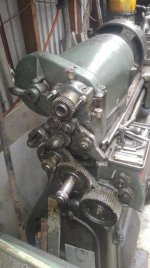john herrick
Plastic
- Joined
- Sep 30, 2019
- Location
- sydney, australia


 I bought this lathe several years ago and have done a fair bit of turning and some threading on it. At purchase the reversing tumbler mechanism was a botched up thing consisting of a brass bushing screwed to a thick plate with a slot to shift position. The bush was turned to fit into the headstock and the center was bored to carry the shaft for the stud gear. Much of this is not concentric, and there is wear in the id. The pair of tumbler gears do not have the same number of teeth. Although there seems to be a spare 24 tooth gear which could be used to make a matched pair. There is also a spare spindle gear of 33 teeth. I think some the gears are original, while others appear to be to thin. I believe some of the change occurred when the original cast reverser was destroyed (?) other changes are perhaps an attempt to cut metric threads.
I bought this lathe several years ago and have done a fair bit of turning and some threading on it. At purchase the reversing tumbler mechanism was a botched up thing consisting of a brass bushing screwed to a thick plate with a slot to shift position. The bush was turned to fit into the headstock and the center was bored to carry the shaft for the stud gear. Much of this is not concentric, and there is wear in the id. The pair of tumbler gears do not have the same number of teeth. Although there seems to be a spare 24 tooth gear which could be used to make a matched pair. There is also a spare spindle gear of 33 teeth. I think some the gears are original, while others appear to be to thin. I believe some of the change occurred when the original cast reverser was destroyed (?) other changes are perhaps an attempt to cut metric threads.the spindle is clearance for 1 inch
the lead screw is 6 tpi I believe
it is a single tumbler qc box
I would like to tidy all this up and return it to near as possible original.
Can any one help me with the following Questions:
1) should the tumbler gears be a pair of 24 tooth gears?
2) what tooth gears should be the inner and outer gears on the on the stud shaft be?
3) if the cast reverser plate is interchangeable with any other size sb lathe. 13s appear to be uncommon
4) is there a current good source for gears



